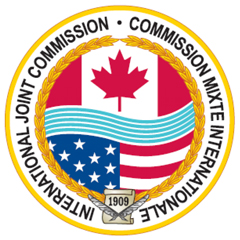 At a meeting of the International Joint Commission (IJC), Canadian Commissioners Pierre Béland, Merrell-Ann Phare and F. Henry Lickers made a solemn declaration to faithfully and impartially perform the duties assigned under the Boundary Waters Treaty. Also announced was that the appointments of Jane Corwin as US Section chair, and Robert Sisson and Lance Yohe as US Section Commissioners has been confirmed by the US Senate.
At a meeting of the International Joint Commission (IJC), Canadian Commissioners Pierre Béland, Merrell-Ann Phare and F. Henry Lickers made a solemn declaration to faithfully and impartially perform the duties assigned under the Boundary Waters Treaty. Also announced was that the appointments of Jane Corwin as US Section chair, and Robert Sisson and Lance Yohe as US Section Commissioners has been confirmed by the US Senate.
Read the full announcements:
 The history of the Rainy River is fascinating. How could it not be with voyageurs and lumberjacks all tangled up in it. The overlooked part of any history lesson, however, is often the timeline of environmental insults that occurred in concert with the industrial revolution and the population of the land and exploitation of its resources.
The history of the Rainy River is fascinating. How could it not be with voyageurs and lumberjacks all tangled up in it. The overlooked part of any history lesson, however, is often the timeline of environmental insults that occurred in concert with the industrial revolution and the population of the land and exploitation of its resources.
In this article, Bev Clark explores the history of the pollution and subsequent research and cleanup of the Rainy River as an example that shows what coordinated international efforts engaging the IJC can achieve.
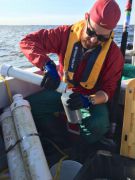 Phosphorus, algae’s favorite food, should be quickly buried by inches of mud year over year. Perhaps, somehow, the phosphorus that had entered the lake during the paper and population booms of the mid-twentieth century is being recycled? Could it be that the turbulent waters of Lake of the Woods south basin (the Big Traverse) are combining with short periods of temperature stratification (when the cold bottom waters of a lake do not mix with the warmer water above) to deplete oxygen and draw nutrients back up from the sediments. Particularly windy days could then mix nutrient rich particles of sediment throughout the water column, allowing pollution from many years ago to be reused over and over again. In this article from the Field Notes - Stories from the St. Croix Watershed Research Station of the Science Museum of Minnesota the story unfolds of research seeking to answer these questions and gain insights into what causes the algae problems plaguing Lake of the Woods.
Phosphorus, algae’s favorite food, should be quickly buried by inches of mud year over year. Perhaps, somehow, the phosphorus that had entered the lake during the paper and population booms of the mid-twentieth century is being recycled? Could it be that the turbulent waters of Lake of the Woods south basin (the Big Traverse) are combining with short periods of temperature stratification (when the cold bottom waters of a lake do not mix with the warmer water above) to deplete oxygen and draw nutrients back up from the sediments. Particularly windy days could then mix nutrient rich particles of sediment throughout the water column, allowing pollution from many years ago to be reused over and over again. In this article from the Field Notes - Stories from the St. Croix Watershed Research Station of the Science Museum of Minnesota the story unfolds of research seeking to answer these questions and gain insights into what causes the algae problems plaguing Lake of the Woods.
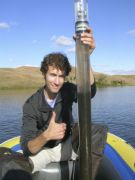 In lakes throughout the upper Midwest, from giant Lake of the Woods to dozens of smaller lakes in our urban and agricultural landscapes, clean water has not obviously followed pollution reductions. The complex connections between land, water, climate, chemistry, algae, and even fish can conspire to make us pay a high price for past sins. This article from the Field Notes - Stories from the St. Croix Watershed Research Station of the Science Museum of Minnesota examines the role of "legacy" phosphorus in the lake bottom and other factors in recovery of lakes from too much nutrient pollution.
In lakes throughout the upper Midwest, from giant Lake of the Woods to dozens of smaller lakes in our urban and agricultural landscapes, clean water has not obviously followed pollution reductions. The complex connections between land, water, climate, chemistry, algae, and even fish can conspire to make us pay a high price for past sins. This article from the Field Notes - Stories from the St. Croix Watershed Research Station of the Science Museum of Minnesota examines the role of "legacy" phosphorus in the lake bottom and other factors in recovery of lakes from too much nutrient pollution.
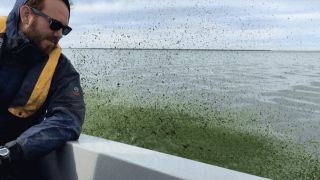 Spanning the U.S.-Canada border at the northern extremity of Minnesota and the northwestern corner of Ontario, vast Lake of the Woods has a storied relationship with humans: as home, as highway, as getaway. Lake of the Woods is well-loved, and troubled. This article from Field Notes -Stories from the St. Croix Watershed Research Station examines the history of pollution and how research studies are improving out understanding the lake’s past and current conditions, including how phosphorus is stored and returned from the lake bottom. These studies are helping us to figure out what forces affect the water quality today -- which is essential to setting clean-up goals and identifying the most effective ways to achieve them.
Spanning the U.S.-Canada border at the northern extremity of Minnesota and the northwestern corner of Ontario, vast Lake of the Woods has a storied relationship with humans: as home, as highway, as getaway. Lake of the Woods is well-loved, and troubled. This article from Field Notes -Stories from the St. Croix Watershed Research Station examines the history of pollution and how research studies are improving out understanding the lake’s past and current conditions, including how phosphorus is stored and returned from the lake bottom. These studies are helping us to figure out what forces affect the water quality today -- which is essential to setting clean-up goals and identifying the most effective ways to achieve them.
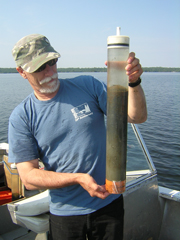 In this article, Bev Clark takes a look at what we've learned about Lake of the Woods from some of the key science published in the 2017 special issue of the Journal of Lake and Reservoir Management that was devoted entirely to Lake of the Woods. How has the lake changed? Are we still paying for our past sins from phosphorus pollution built up in the lake bottom? And what role does climate change have?
In this article, Bev Clark takes a look at what we've learned about Lake of the Woods from some of the key science published in the 2017 special issue of the Journal of Lake and Reservoir Management that was devoted entirely to Lake of the Woods. How has the lake changed? Are we still paying for our past sins from phosphorus pollution built up in the lake bottom? And what role does climate change have?
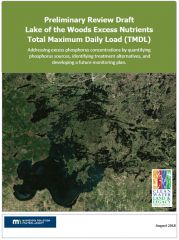 Minnesota’s plan to cut phosphorus entering Lake of the Woods was submitted to US EPA for review last fall as the first step in the approval process. The MPCA is currently responding to the federal review, prior to taking the plan forward through a formal public consultation period, anticipated for later this summer. We’ll keep you informed via the Foundation’s website and e-news about progress on the Minnesota plan and opportunities for public input.
Minnesota’s plan to cut phosphorus entering Lake of the Woods was submitted to US EPA for review last fall as the first step in the approval process. The MPCA is currently responding to the federal review, prior to taking the plan forward through a formal public consultation period, anticipated for later this summer. We’ll keep you informed via the Foundation’s website and e-news about progress on the Minnesota plan and opportunities for public input.
Watch for word coming out for public meetings in Minnesota (International Falls, Baudette and Warroad) and a WebEx online conference for folks in Canada and others who cannot attend in person.
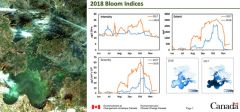 The satellite view from space is compelling of blue green algae blooms covering Lake of the Woods. Dr. Caren Binding of ECCC is harnessing these images for near real-time tracking of algae blooms and to develop indices of bloom severity, intensity, extent and duration. These indices may prove to be very useful in monitoring and measuring the effectiveness of efforts to cutting phosphorus to reduce harmful algae blooms.
The satellite view from space is compelling of blue green algae blooms covering Lake of the Woods. Dr. Caren Binding of ECCC is harnessing these images for near real-time tracking of algae blooms and to develop indices of bloom severity, intensity, extent and duration. These indices may prove to be very useful in monitoring and measuring the effectiveness of efforts to cutting phosphorus to reduce harmful algae blooms.
Profiles of this project and the other science projects underway by Environment and Climate Change Canada on Lake of the Woods are available at the Foundation’s website: www.lowwsf.com/eccc-science.
